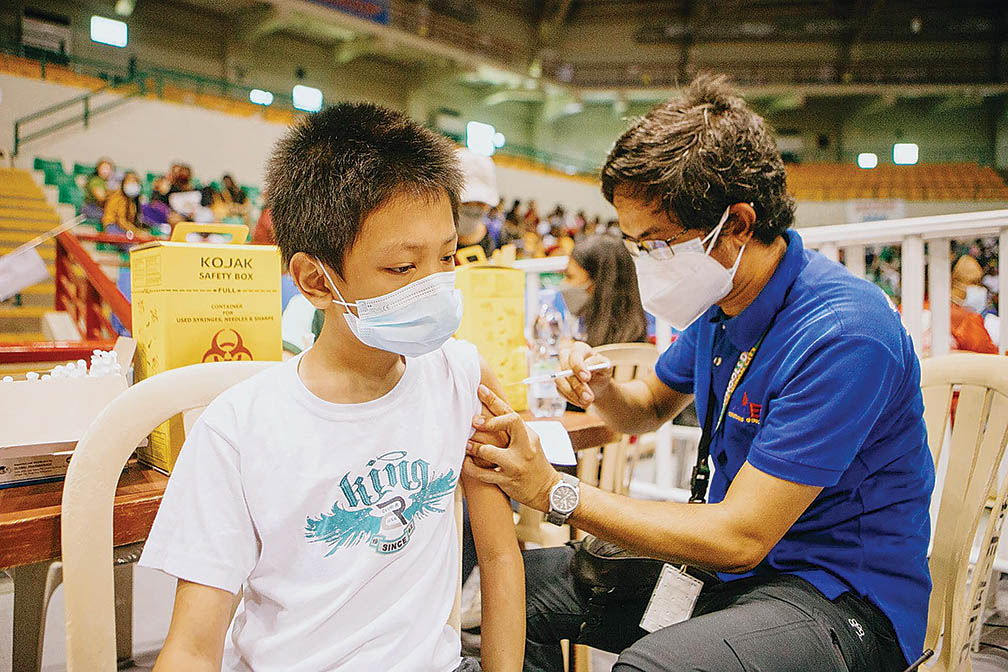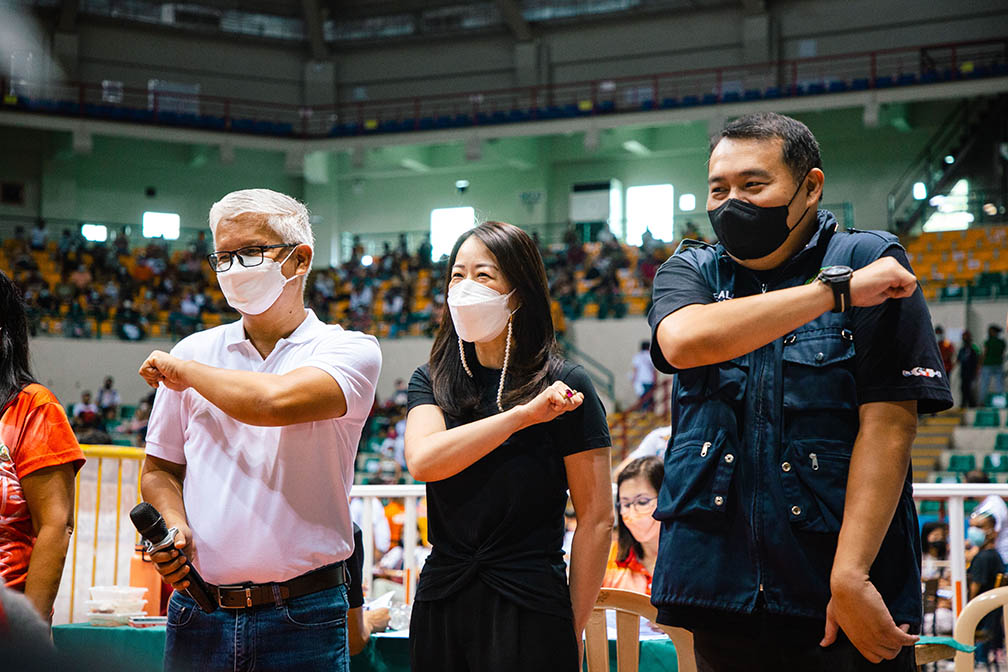When the Inter Agency Task Force for the Management of Emerging Infectious Diseases (IATF) announced that the vaccination of the pediatric population, ages 12 to 17 years old, would push through in October 2021, the City of Biñan was ready to go full blast.
In fact, Biñan City Mayor Walfredo “Arman” Dimaguila Jr. estimated that by the first week of December 2021, the city would have completed the vaccination of children aged between 12 and 17 years old. This would enable the city to apply for face-to-face classes for Grades 7 to 12 starting January 2022.
“Our strategy to vaccinate the youth ages 12 to 17 years old per school has been doing well. Through the coordination with the City Education Office, Department of Education Biñan and our vaccination sites and partner hospitals, since November 15, 2021, we have already administered the first doses to 15,000 youth from the 22,052 pre-registered,” he said. “It is fast moving. Our strategy in vaccinating the youth per school has been successful.”
Biñan Rep. Marlyn “Len” Alonte noted that the vaccination for the youth has been generating positive and overwhelming responses from both parents and the children.
“This is the only way we can all go back to the normalcy that we all crave for. I was there on the first day of the vaccination for the youth program and I saw the willingness of these children to do their part in ending this pandemic by getting inoculated,” she said.

Not too bad
When asked about the COVID-19 situation in Biñan, Rep. Alonte noted that the situation in the city was not as bad as in the other cities and municipalities in Laguna.
“We are lucky that the local government was able to put the situation under control through strict lockdowns as mandated also by the national government. Most of the COVID patients have already recovered and we only have five constituents who are still recovering. Based on data as of December 1, 2021, our city has recorded 183 deaths,” she said, adding that the number includes residents working outside of Biñan but who live permanently in the city.
However, Dimaguila is closely monitoring developments on Omicron, the latest Covid-19 variant to emerge. Since one of Biñan’s strength is its healthcare system, Dimaguila is confident that they prepared for the new variant.
“We are preparing for it. We will bring back what we did last year and when Delta was around. We will put in place the quarantine facilities, we will tap all the frontliners once again,” he said.
The quarantine facility that Dimaguila mentioned is the Polytechnic University of the Philippines- Biñan campus, which was converted in April 2020 into a dedicated quarantine facility while a temporary emergency quarantine facility for Covid-19 patients was also built in Ospital ng Biñan with the help of Gardenia Bakeries Inc. and the United Architect Philippines-Metro.

The Biñan City Government has decided to close for the time being the Temporary Treatment and Monitoring Facility at the People’s Center since there are no more positive Covid-19 patients.
Christmas amidst the pandemic
The Christmas spirit is alive and well in Biñan as the Rizal Plaza and the City Hall is adorned with Christmas decorations. However, the mayor said he will ask Biñanenses to refrain from having Christmas parties because the virus is still around. However, the city government will be giving away Pamaskong Bayongs to government employees and Biñan residents. The other funds that we can save will be used to augment Covid relief.
“And then we will continue to encourage and inspire the people. You inspire them amidst the pandemic when the number of Covid cases are rising and more deaths are occurring. Or, you can inspire them to observe minimum health protocols because the number of cases going down,” he explained.
While the vaccination of the pediatric group was a success, there are still many Biñanenses above the age of 18 who are still undecided on getting the COVID-19 vaccination. Vice Mayor Angelo “Gel” Alonte estimates that almost 80 percent of the population of Biñan has been vaccinated.
The vaccine of choice for most Biñanenses is Pfizer, probably one of the reasons why the vaccination drive for the 12 to 17 age group was successful. When they find out that the vaccination centers offer the not so popular brands, some people refuse to take them.
While Biñan wants to fully vaccinate all residents, the city government still has to rely on the supply given by the national government. As of November 30, 2021, total doses administered was at 173,607—with 76,625 were fully vaccinated.
Biñan also joined the National Immunization Days and records show that 11,842 were vaccinated on November 29; 8,932 on November 30 and 6,521 were vaccinated on December 1.
Vax on Wheels
Another strategy that the city government adopted to achieve their high vaccination rates is Vax on Wheels. Dimaguila said at first they were not sure if the national government, particularly the Department of Health, would allow the city to conduct vaccinations outside of vaccination sites.
“We saw that this would be the best way to reach our constituents. We would be the ones to go to them for vaccination. We finally got the approval and we made use of two buses,” he said.
During the lockdowns, the city government was forced to abandon several infrastructure projects in order to have extra funds for rapid response. Residents who were diagnosed with COVID-19 were given P20,000 in assistance plus essential items.
“We did not rely solely on the funds that came from the national government. We augmented this by putting some of our projects on hold,” Vice Mayor Alonte related. “We made sure that everyone, including those who live in gated subdivisions, received government assistance.”
“Imagine, even the residents of Brentville, the rich subdivisions, the middle-income subdivisions received government assistance. This was the first time in the history of Biñan that government assistance was brought to their doorsteps,” he said.
In April 2020, the Biñan city government in partnership with Iskolar ng Biñan spearheaded a month-long donation drive for medical healthcare workers. About 2,000 healthcare workers in different clinics and hospitals received a box containing alcohol, hairnet, face shields, N95 masks, PPEs, surgical gloves, vitamins and washable face masks.
Challenges
Despite the economic challenges brought about by the pandemic, the city government was still able to push through with the needed infrastructure projects. Dimaguila said the government cannot afford to slow down just because of the pandemic, adding that there’s a need to maximize the city government’s resources and assure Biñanenses that the pandemic will not stop the local government from bringing quality service and projects to its people.
“One of the projects that continued during the pandemic was the construction of the new Ospital ng Biñan building which is now 65 percent complete,” he said.
The Ospital ng Biñan is a Level 1 medical facility with a capacity of 50 beds. If Rep. Alonte had her way, she would have wanted to upgrade Ospital ng Biñan into a tertiary hospital that would enable them to offer more services to their constituents. She is also prepared to set aside a budget to purchase the necessary medical equipment. This, however, would depend on the requirements laid down by the Department of Health.
“Now more than ever, we know the value of health and well-being and how it is as important in our growth as a city and as a nation. We wanted to ensure that local government initiatives on health are given top priority through programs such as the HAPI Card which I started as city mayor,” Rep. Alonte said.
“This program targets the poor and marginalized residents of the city and provides them with free and subsidized medical care. With the pandemic, I am sure the local government will put in place a more responsive medical program for the poor,” she added.
With regards to public health safeguards, Rep. Alonte said the city operates with the mindset that with or without COVID-19, all government offices should always be subjected to regular and thorough cleaning and disinfection. She added that all schools are currently being prepared for the opening of face-to-face classes.
“The campus and classrooms should conform with the guidelines set forth by the national and regional IATF to ensure the safety of everybody. We are in constant talks with the agencies involved in all these programs,” she said.
Image Credits: Aldrin Gonzales, Biñan City Congressional District Office.


